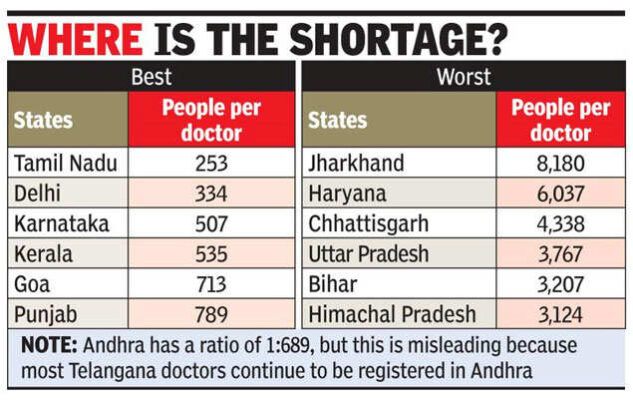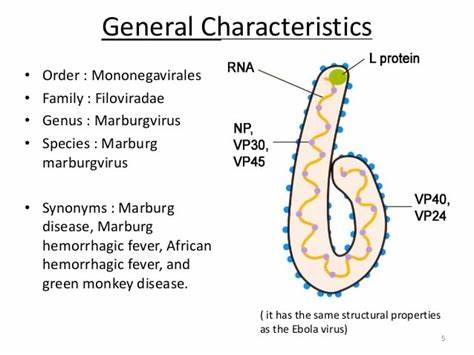- Home
- Prelims
- Mains
- Current Affairs
- Study Materials
- Test Series
11th Aug 2021
THE DOCTOR-POPULATION RATIO IN INDIA IS 1:1456 AGAINST WHO RECOMMENDATION
Recently, the Ministry of Science & Technology has stated that India is well on the path towards WHO recommended doctor to population ratio.
WHO recommended Doctor to Population Ratio?



- The SDG agenda gives recognition to Universal Health Coverage as key to achieving all other health targets.
- The SDG 3c sets a target to substantially increase health financing and the recruitment, development, training and retention of the health workforce in developing countries, especially in least developed countries and Small Island developing States.
- WHO and its partners developed the Global Strategy on Human Resources for Health: Workforce 2030 (GSHRH) to accelerate progress towards UHC and the SDGs.
- The doctor-population ratio in India is 1:1456 against the WHO recommendation of 1:1000.
- India is well on the path to have one doctor per thousand population by 2024.
- India is increasing the number of beds from 11 lakh to 22 lakhs.
- At the time of Independence, the average life was just 28 years, and it has now reached close to 70 years.

- On an average, a government doctor attends to 11,082 people, more than 10 times than what the WHO recommends.
- The shortage of government doctors does not augur well for India where 70 per cent of health care expenses are met by out-of-pocket expenditure.
- India is terribly short of government doctors: India’ health care sector is battling a major crisis i.e. inadequate infrastructure and human resource.
- Over the last nine years, shortage of medical staff, especially doctors, claimed lives of 72,000 infants in government hospitals of Madhya Pradesh.
- Rural India is bearing the maximum brunt: The country had a shortfall of 10,112 female health workers at primary health centres, 11,712 female health assistants, 15,592 male health assistants and more than 61000 female health workers and auxiliary nurse mid-wifes at sub-centres.
- Shortage of other medical staff: There are reportedly 462 medical colleges that churn out 56,748 doctors every year.
- With India’s population increasing by about 26 million each year, the increase in number of medical staff is too little.
- Ayushman Bharat Yojana and Jan Arogya Yojana are the programmes that focus on providing all kinds of health facilities to people and are steps towards universal health coverage, affordability and accessibility to health facilities.
- Under Jan Arogya Yojana, 50 Crore people are eligible now for affordable health services.
- By the year 2022, 150,000 primary health care centres would be in place in rural as well as urban areas of the country, and these centres would be hub for primary health care.
- The maximum intake capacity at MBBS level has been increased from 150 to 250, the norms for setting up of Medical Colleges in terms of requirement of land, faculty, staff bed strength etc have been rationalized.
- The Government has also supported States to add nearly 2.51 lakh additional health human resources including General Duty Medical Officers, Specialists, Staff Nurses, Auxiliary Nurse Midwives (ANMs), Paramedics, Public Health Managers and Programme Management staff on a contractual basis
- The principles proposed by the Prime Minister are:
- Removing barriers from legitimate maritime trade,
- Encouraging responsible maritime connectivity,
- Settling maritime disputes through peaceful means and based on international law,
- Jointly facing natural disasters and maritime threats created by non-state actors, and
- Preserving the maritime environment and resources
- The debate on maritime security was one of three signature events being organised by India during its presidency of the Security Council.
- The statement promotes safe and secure shipping while ensuring freedom of navigation in line with international laws.
- It seeks enhanced cooperation to protect critical infrastructure, including cross-border infrastructure.
- India’s statement on maritime security contained a tacit reference to China’s aggressive actions in the South China Sea.
- Growing interlinked threats: The maritime insecurity is also compounding the terrorist threat and the growing and interlinked threats call for a truly global and integrated response.
- Shared global commons: The UN estimates that more than three billion people worldwide, mainly in developing countries, depend on the ocean for their livelihood and well-being.
- It is engaged in the business of maritime security, providing escort and guard services to the marine industry on a worldwide basis.
- Maritime security is being undermined by challenges around contested boundaries and navigation routes, and depletion of natural resources through illegal or unreported fishing.
- Thievery: When transporting valuable goods and resources, there are sometimes attempts at the local level to steal these goods from vessels.
- Trespassing: Large-scale security measures concern things that can happen on an international scale, usually as the result of more malicious operations than individual crimes, like terrorism, environmental crimes, smuggling and trafficking.
- Illegal Maritime Trade: A side effect of increasing maritime trade and economic globalization is that it will facilitate the expansion of transnational crime.
- Trafficking in drugs, arms and people is already big business, and maritime shipping is a crucial method of transport.
- Human Trafficking: It is another one of the main issues that face international marine security.
- Illegal migration has been present in the maritime sector for a long time, whether it’s people escaping political unrest or unwilling people being trafficked.
- It is difficult for the marine industry to catch all the illegal immigration, but proper marine security techniques help minimize the problem.
- Environmental Damage: Because large-scale commercial operations take place in the ocean ecosystem, there will inevitably be incidents that harm the environment.
- It is the job of marine security officers to help ensure that their vessel’s operations harm the environment as little as possible.
- The government will invest more than ₹11,000 crore in the mission to provide farmers everything possible, including better seeds and technology.
- The Centre plans to raise the domestic production of palm oil by three times to 11 lakh MT by 2025-26.
- It will involve raising the area under oil palm cultivation to 10 lakh hectares by 2025-26 and 16.7 lakh hectares by 2029-30.
- Under the scheme, oil palm farmers will be provided financial assistance and will get remuneration under a price and viability formula.
- India produces less than half of the roughly 2.4 crore tonnes of edible oil that it consumes annually.
- It imports the rest, buying palm oil from Indonesia and Malaysia, soyoil from Brazil and Argentina, and sunflower oil, mainly from Russia and Ukraine.
- The country does export agricultural commodities such as sugar and rice on the world market, but domestic oilseed production is nearly six times lower than rice and wheat on average.
- India's vegetable oil imports have surged to 1.5 crore tonnes from 40 lakh only two decades ago.
- It aims to make India self-sufficient in cooking oils, including palm oil and reducing the dependence on imports.
- It will ensure that farmers get all facilities, from quality seeds to technology to promote farming to produce palm oil and other oil seeds.
- It’s expected to incentivize production of palm oil to reduce dependence on imports and help farmers cash in on the huge market.
- The special emphasis of the scheme will be in India's north-eastern states and the Andaman and Nicobar Islands due to the conducive weather conditions in the regions.

- It belongs to the Nathusius’ pipistrelle species of bats.
- The Nathusius’ pipistrelle is found across Europe from the U.K. to Asia Minor.
- It was discovered by a resident of a small Russian village called Molgino, which is located in the Pskov region of Russia.
- The Bat Conservation Trust launched a project called the National Nathusius’ Pipistrelle Project in 2014.
- It aims to improve our understanding of the ecology, status and conservation threats for Nathusius’ pipistrelles in Great Britain.
- Its goal is to determine the migratory origins of this species of bats since they might help in understanding its links to climate change.
- The journey is significant because it is the longest one undertaken by a bat from Britain across Europe.
- Its record is topped by another bat from the same species that flew from Latvia to Spain in 2019 covering 2,224 km.
- The journey is important for climate scientists as it gives them the window to learn more about bat migration and how it relates to climate change.
- Bat Conservation Trust UK believes that Nathusius’ pipstrelle’s range of bats is linked to climate change and that any climate changes in future will further impact this species.

- It is a severe, often fatal illness in humans, formerly known as Marburg haemorrhagic fever.
- Marburg virus disease is a highly virulent disease that causes haemorrhagic fever, with a fatality ratio of up to 88%.
- It is in the same family as the virus that causes Ebola virus disease.
- The two large outbreaks that occurred simultaneously in Marburg and Frankfurt in Germany, and in Belgrade, Serbia, in 1967, led to the initial recognition of the disease.
- The outbreak was associated with laboratory work using African green monkeys (Cercopithecus aethiops) imported from Uganda.
- Human infection with Marburg virus disease initially results from prolonged exposure to mines or caves inhabited by Rousettus bat colonies.
- It can spread through human-to-human transmission via direct contact (through broken skin or mucous membranes) with the blood, secretions, organs or other bodily fluids of infected people, and with surfaces and materials (e.g. bedding, clothing) contaminated with these fluids.
- The Health-care workers have frequently been infected while treating patients with suspected or confirmed MVD which has occurred through close contact with patients when infection control precautions are not strictly practiced.
- Transmission via contaminated injection equipment or through needle-stick injuries is associated with more severe disease, rapid deterioration, and, possibly, a higher fatality rate.
- The incubation period (interval from infection to onset of symptoms) varies from 2 to 21 days.
- The Illness caused by Marburg virus begins abruptly, with high fever, severe headache and severe malaise. Muscle aches and pains are a common feature.
- Severe watery diarrhoea, abdominal pain and cramping, nausea and vomiting can begin on the third day.
- Many patients develop severe haemorrhagic manifestations between 5 and 7 days, and fatal cases usually have some form of bleeding, often from multiple areas.
- Fresh blood in vomitus and faeces is often accompanied by bleeding from the nose, gums, and vagina.
- Currently there are no vaccines or antiviral treatments approved for MVD.
- The supportive care i.e. rehydration with oral or intravenous fluids and treatment of specific symptoms, improves survival.
- There are monoclonal antibodies (mAbs) under development and antivirals e.g. Remdesivir and Favipiravir that have been used in clinical studies for Ebola Virus Disease (EVD) that could also be tested for MVD.
- Rousettus aegyptiacus bats are considered natural hosts for Marburg virus.
- There is no apparent disease in the fruit bats.
- The geographic distribution of Marburg virus may overlap with the range of Rousettus bats.
- African green monkeys (Cercopithecus aethiops) imported from Uganda were the source of infection for humans during the first Marburg outbreak.









 Latest News
Latest News
 General Studies
General Studies